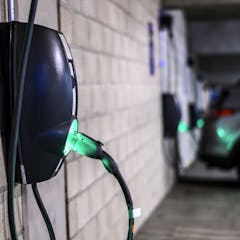
Articles on Electric vehicles (EVs)
Displaying 81 - 100 of 332 articles

Having once led Europe in zero-carbon cars, the UK has some catching up to do.

Hydrogen cars were heralded as an avenue towards universal green motoring, but progress has stalled in recent years.

Public buses, subways and trains are relatively safe, fast and cheap. But competition from rideshares and concerns over COVID-19 will soon see some local agencies short of funds.

Labor and the Coalition are promising $19 billion between them for transport projects – way down on the $163 billion promised in 2018 – but they’re as scornful of proper assessment processes as ever.

Start high, drop fast and avoid the free-riders: How to design subsidies that can boost clean energy in the US and elsewhere.

Major new policies are still needed to accelerate the road transport transition. There’s good news, however: Australian motorists have been promised more choice soon.

How does keeping the price of petrol and diesel down align with New Zealand’s goal of being carbon zero by 2050? And do price caps even work anyway?

As California goes on regulating air pollution, other states often follow – including the Golden State’s ambitious goals for cleaning up emissions from trucking.

The budget earmarked worthwhile climate measures, but many are piecemeal. Amid record-breaking extreme weather in Australia, federal spending on climate action still falls well short.

The rise of e-commerce means billions of packages are delivered in the US each year. That creates traffic and pollution, but urban freight researchers are finding better way to get goods to customers.

Australia’s richest man recently took on the world’s richest man over the shape of our green future. But it’s not either batteries or green hydrogen – we need both.

Reducing air pollution from cars and light trucks would pay big health dividends for low-income and minority communities. A new survey shows how to get more drivers of color into electric vehicles.

A technique called ‘energy arbitrage’ allows owners of local ‘microgrids’ to make a profit by designing the network to buy cheap power, store it and sell it back at a higher price.

SUVs made up half of all new car sales last year. They’re a drag on Australia successfully reducing its total greenhouse gas emissions.

Air pollution from traffic causes the deaths of thousands of Australians. A swift transition to electric vehicles will save lives – and save households and businesses money in the long run.

Australia last week moved to tackle the climate crisis when federal parliament passed Labor’s climate bill. But the new law is just the first step.

We’ve heard all the concerns about switching to electric cars before. But California, a market with many similarities, shows why Australia is well placed to accelerate its transition.

Electric vehicles were around long before their fossil fuel rivals. They are also set to outlast them because of advantages their advocates noted as early as a century ago.

China controls much of the global EV supply chain, but electric vehicles that use its parts and minerals won’t qualify for new US EV tax credits. Can America build its own supply chain?

On-demand public transit can rival car ownership in convenience, while cutting emissions and cost, and simultaneously encouraging a mode shift towards public transport.
